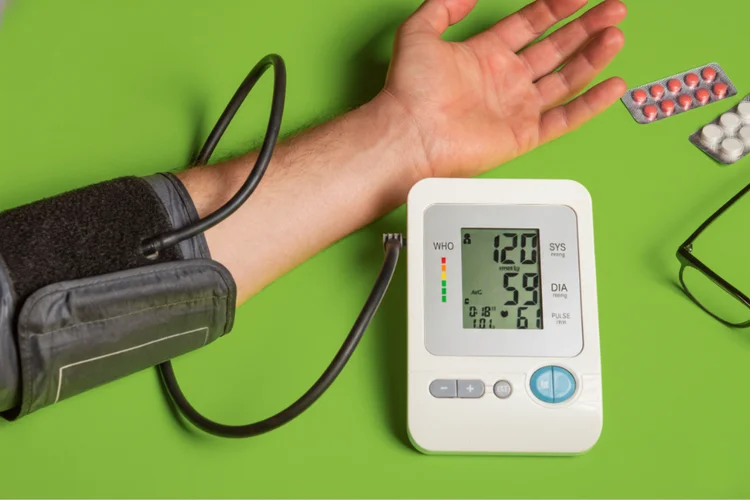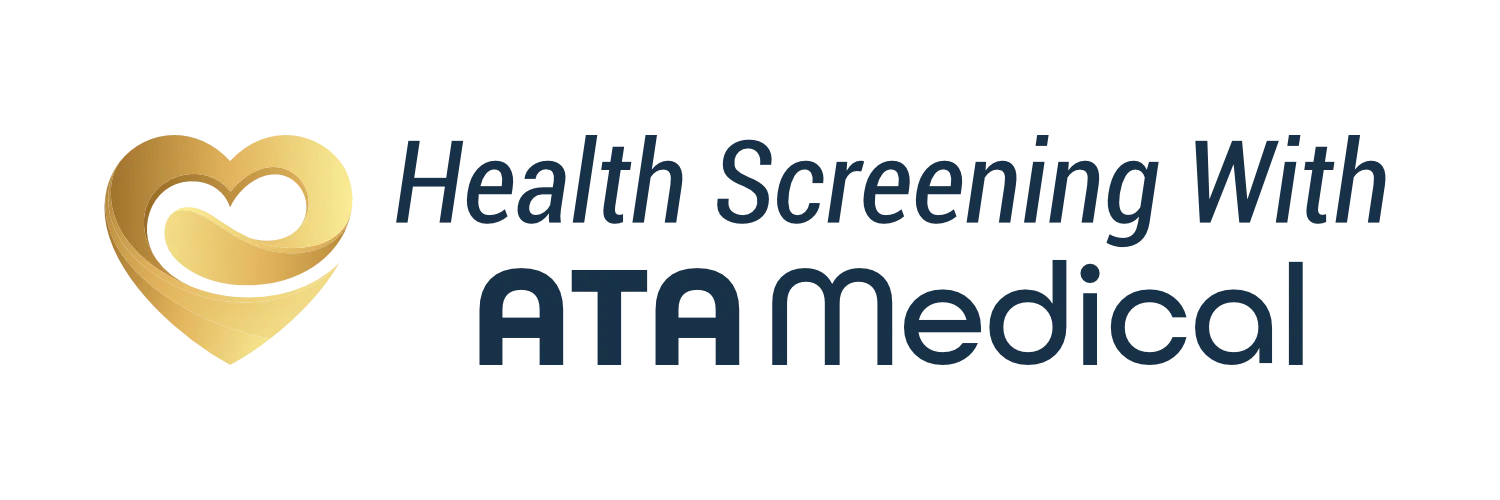What Do Blood Pressure Readings Mean?
A blood pressure reading indicates how much force your blood applies to
the artery walls as it circulates through your body, serving as a
key measure of heart and vascular health.
Each reading is made up of two values that represent different phases of the heartbeat:
- Systolic pressure (upper number) – The pressure when the heart contracts and pushes blood into the arteries.
- Diastolic pressure (lower number) – The pressure when the heart relaxes between beats.

Together, these numbers help evaluate whether blood pressure levels fall within a
healthy range or suggest hypertension.
High blood pressure often develops silently, without obvious symptoms, yet it
significantly increases the risk of heart attack, stroke, and kidney
damage.
How Is Blood Pressure Expressed?
Blood pressure is expressed in millimetres of mercury (mmHg), written as systolic over diastolic, for example, 120/80 mmHg. In Singapore, readings are generally interpreted based on the following categories:
| Categories | Systolic Blood Pressure (mmHg) | Diastolic Blood Pressure (mmHg) |
|---|---|---|
| Normal | < 120 | < 80 |
| High-Normal (Borderline) | 130 – 139 | 85 – 89 |
| Hypertension Stage 1 | 140 – 159 | 90 – 99 |
| Hypertension Stage 2 | ≥ 160 | ≥ 100 |
What Is Considered a Healthy Blood Pressure by Age?
A healthy blood pressure reading generally stays around 120/80 mmHg across all
age groups, though acceptable values can vary depending on overall health,
medications, and age-related changes.
As people grow older, arteries gradually
lose elasticity, making it harder for the heart to pump blood efficiently. This
can cause a gradual rise in systolic pressure, especially after the age of 50, which may
still be considered acceptable if diastolic pressure stays stable and other
cardiovascular risks are well controlled.
Factors such as hormonal fluctuations, reduced kidney performance, and lifestyle
patterns such as diet and stress can further influence these readings.
Disclaimer: These figures serve only as a general guide. You should
always consult your doctor on what blood pressure range is appropriate for your
individual health profile and medical history.
When Should You Monitor Your Blood Pressure?
Blood pressure monitoring should begin early in adulthood and continue regularly throughout life, especially for those with health or family risk factors. Consider checking your blood pressure if:
- You are 18 or older and have not had a recent health screening.
- You have been prescribed medication for hypertension or heart-related conditions.
- There is a family history of high blood pressure or cardiovascular disease.
- You experience frequent headaches, dizziness, blurred vision, or chest tightness.
Monitoring allows early detection of unusual changes in blood pressure and helps track how well current treatments or lifestyle adjustments are working.

Tips for Measuring Your Blood Pressure at Home
Accurate home monitoring provides valuable insight into cardiovascular health, but readings can vary if the technique is inconsistent. To obtain reliable results, follow these tips:
- Use a validated upper-arm digital blood pressure monitor that has been tested for accuracy.
- Ensure the cuff fits properly and is positioned correctly. It should wrap snugly around your bare upper arm, with the lower edge about 2 to 3 cm above the elbow.
- Measure your blood pressure at the same time each day, preferably before breakfast or taking any medication.
- Sit quietly for five minutes before starting.
- Keep your back supported, your arm at heart level, and both feet flat on the floor.
- Take two or three readings one minute apart and record the average.
Always follow your doctor's guidance on when and how to measure, as consistent readings help track progress and inform treatment decisions over time.
What Can Affect Blood Pressure Readings?
Temporary fluctuations in blood pressure are common and can result from several short-term factors:
- Dietary substances – Caffeine, alcohol, or tobacco use can alter readings.
- Emotional stress – Anxiety, pain, or tension can temporarily raise pressure.
- Body position – Sitting with crossed legs or unsupported arms can distort readings.
- Recent activity – Physical exertion just before testing may cause higher results.
- Time of day: Blood pressure naturally varies, often peaking in the morning.
For consistent readings, avoid stimulants such as caffeine for at least 30 minutes before measuring, sit quietly for a few minutes beforehand, and try to keep the same conditions each time you take your blood pressure.

What to Do If Your Blood Pressure Reading Is High?
A high reading does not always mean hypertension, but it should not be ignored. If you notice elevated numbers:
- Recheck your blood pressure after a few minutes to confirm accuracy.
- Think about any recent stress, caffeine intake, or exercise that may have affected it.
- If repeated readings remain high, schedule a review with your doctor.
- Adopt lifestyle changes such as reducing salt, increasing physical activity, moderating alcohol, and managing stress.
Your doctor may recommend ongoing monitoring, further testing, or medication depending on your overall risk profile. Consistent management can help maintain healthy blood pressure and reduce long-term complications.
Navigate Easy With Google Maps
Health Screening Singapore
(Anson House)
Health Screening Singapore
(Camden Medical Centre)
Frequently Asked Questions (FAQ)
A blood pressure monitor displays two numbers: the upper (systolic) reading shows the pressure when the heart contracts, while the lower (diastolic) reading reflects the pressure when the heart relaxes between beats. Readings are expressed in millimetres of mercury (mmHg), such as 120/80 mmHg. The results help determine if blood pressure is within a normal range or elevated. If you are unsure, consult your doctor for guidance on measuring your blood pressure.
Blood pressure readings indicate how strongly blood pushes against artery walls. A normal reading is usually below 120/80 mmHg, while consistent values above this may suggest hypertension. High readings mean the heart and blood vessels are under increased strain, which can raise the risk of heart disease or stroke. It is advisable to discuss your readings with your doctor for proper interpretation and ongoing monitoring.
Irregular readings are common and can result from temporary factors such as stress, caffeine, or recent activity. However, frequent fluctuations or persistently high readings may indicate an underlying condition such as hypertension. If your readings remain inconsistent or unusually high, it is advisable to review them with your doctor to determine whether further monitoring or assessment is needed.
A high diastolic reading means the lower number stays elevated even when the heart is at rest, suggesting that the arteries may be stiff or under strain. This can result from stress, unhealthy lifestyle habits, or underlying medical conditions. Persistently high diastolic pressure increases the risk of heart and vascular disease, so it is advisable to consult your doctor to interpret your results and determine whether further assessment or treatment is needed.
Yes, using a cuff that is too tight or too small for your arm can temporarily raise blood pressure readings by restricting blood flow. To obtain accurate results, the cuff should fit snugly but comfortably and be positioned at heart level. If you are unsure whether your cuff size is appropriate, it is best to check with your doctor or pharmacist for guidance.
For most healthy older adults, an ideal blood pressure is generally around 120/80 mmHg, although slightly higher systolic values may be acceptable due to natural changes in blood vessel elasticity with age. The optimal range can differ based on overall health, medications, and medical history. It is advisable to consult your doctor to determine the most appropriate target blood pressure for your individual condition.
A dangerously high blood pressure reading is generally 180/120 mmHg or above, which may indicate a hypertensive crisis requiring immediate medical attention. Conversely, blood pressure below 90/60 mmHg is considered low and may cause dizziness or fainting. Extremely low levels can reduce blood flow to vital organs. If you experience symptoms such as chest pain, confusion, or fainting, seek urgent medical care.
Both systolic and diastolic readings are important, as each provides insight into heart and blood vessel health. The systolic number, reflecting pressure during heartbeats, tends to rise with age and is often used to diagnose hypertension. The diastolic number measures pressure between beats and can indicate how well the arteries relax. Persistently high values in either reading warrant medical assessment and ongoing monitoring.
A normal blood pressure reading in Singapore is typically below 120/80 mmHg. Hypertension is usually diagnosed when readings consistently reach or exceed 140/90 mmHg, based on local clinical guidelines. Blood pressure that falls between these levels may be considered borderline or "high-normal." It is advisable to monitor your readings regularly and consult your doctor if they remain elevated.
Normal blood pressure for most age groups is typically around 120/80 mmHg, although slightly higher values may be acceptable in older adults due to natural changes in blood vessel elasticity. The ideal range can differ depending on individual health, medications, and medical history. These figures are general guidelines, and it is advisable to consult your doctor for personalised recommendations based on your overall health.
A blood pressure reading of 180/120 mmHg or higher is often referred to as "stroke level," as it greatly increases the risk of stroke, heart attack, or organ damage. This condition is considered a medical emergency and requires immediate evaluation and treatment. If you record a reading in this range or experience symptoms such as severe headache, chest pain, or blurred vision, seek emergency medical attention right away.
Blood pressure is usually highest in the morning shortly after waking and lowest at night during sleep. This daily pattern, known as the circadian rhythm, is influenced by hormonal changes and activity levels. Morning surges are normal but can pose a greater risk for individuals with hypertension or other heart conditions. Regular monitoring at consistent times helps provide a more accurate picture of your overall blood pressure pattern.
Blood pressure cannot be safely lowered instantly without medical supervision, but resting quietly, practising deep breathing, and avoiding caffeine or stress can help bring it down gradually. Long-term management involves healthy eating, regular exercise, and medication if prescribed. If your blood pressure is extremely high, such as 180/120 mmHg or above, seek immediate medical attention.
Foods high in sodium, particularly processed and packaged foods, are among the main contributors to high blood pressure. Excess salt causes the body to retain fluid, which increases pressure on blood vessel walls. Reducing intake of salty snacks, instant noodles, canned soups, and fast food can help maintain healthier levels. Reading nutrition labels and choosing fresh ingredients are simple ways to lower sodium consumption.
A blood pressure reading of 140/90 mmHg is generally classified as Stage 1 hypertension. While it is not immediately dangerous, it indicates that your blood pressure is higher than recommended and should be monitored. Consistently elevated readings may require lifestyle changes or treatment to reduce long-term risks. It is advisable to discuss your readings with your doctor for proper evaluation and management.
Drinking enough water helps maintain proper blood volume and circulation, which may support healthy blood pressure. However, water alone does not directly lower high blood pressure. The most effective approach includes reducing salt intake, staying physically active, and following your doctor's prescribed treatment if necessary. Keeping well hydrated remains an important part of overall heart and vascular health.
Yes, inadequate or poor-quality sleep can contribute to elevated blood pressure over time. Sleep deprivation affects stress hormones and the body's ability to regulate blood vessel function, which can lead to sustained increases in pressure. Chronic insomnia or sleep apnoea may further raise cardiovascular risk.
